We decorate our areas with decorative curly beans
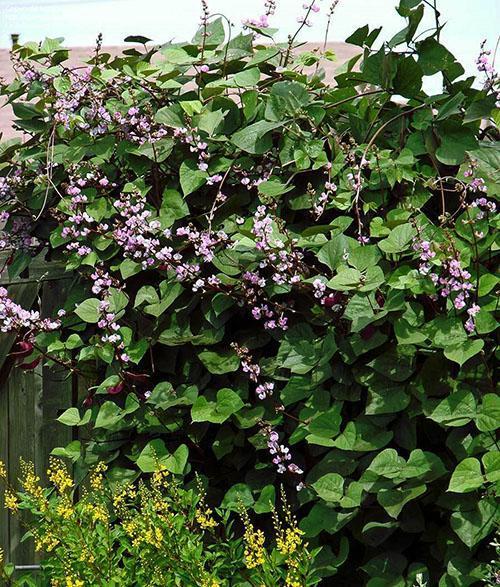 Various types of green beans and grain beans have long been used with pleasure by humans for food, as fodder crops and green manure. But at the same time, one more role of the plant has not been forgotten. Curly beans are decorative and for three and a half centuries has occupied an honorable place among green jewelry garden, greenhouse and even a modest balcony.
Various types of green beans and grain beans have long been used with pleasure by humans for food, as fodder crops and green manure. But at the same time, one more role of the plant has not been forgotten. Curly beans are decorative and for three and a half centuries has occupied an honorable place among green jewelry garden, greenhouse and even a modest balcony.
The advantages of decorative curly beans are:
- high growth rate, allowing large vertical surfaces to be landscaped during the spring-summer season;
- unpretentiousness;
- a variety of shapes and colors appearing on the shoots of inflorescences;
- long preservation of attractiveness due to the presence of not only spectacular inflorescences, but also pods, sometimes striking with an unusual appearance;
- the possibility of using the green mass of the plant for green fertilizers and composts;
- enrichment of the soil with nitrogen that accumulates on the roots of plants of this family.
The only thing that needs to be considered when planting beans is the heat-loving nature of the plant and the culture's need for light and abundant nutrition.
Competently using the plant's ability to climb to a height of 2 to 5 meters and combining different varieties of climbing beans, you can equip unusual green arbors, create arches in the garden and refine the most unpresentable corners and hedges.
It is important that several independent species belonging to the legume family, but with unique properties and appearance, are used for landscaping today. Moreover, all these crops are valued both as decorative and vegetable plants.
Common beans (Phaseolus vulgaris)
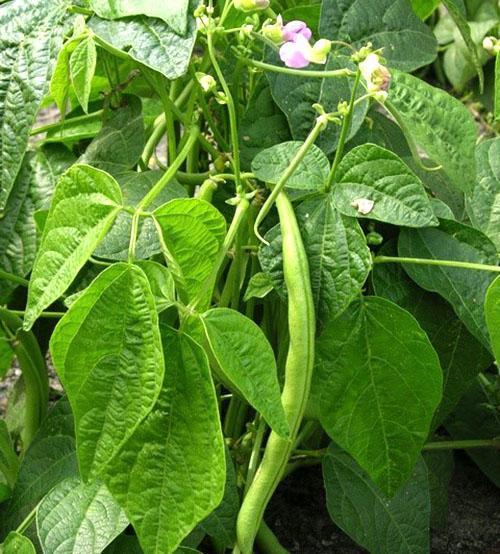 The common climbing beans are well known and loved by Russian gardeners. An annual plant, native to Latin America, it perfectly combines the properties of a vegetable crop that delivers green pods and ripe seeds to the table, and high decorativeness. Curly beans in height can reach from 1.5 to 3 meters, already a month after sowing, they form the first inflorescences, and with proper care, feeding and watering flowering and pod formation continues until mid-autumn.
The common climbing beans are well known and loved by Russian gardeners. An annual plant, native to Latin America, it perfectly combines the properties of a vegetable crop that delivers green pods and ripe seeds to the table, and high decorativeness. Curly beans in height can reach from 1.5 to 3 meters, already a month after sowing, they form the first inflorescences, and with proper care, feeding and watering flowering and pod formation continues until mid-autumn.
The decorative effect is also small, but numerous flowers of various colors, and dense foliage, and pods hanging from the stems of varying degrees of maturity. Regular harvesting of green beans on many varieties of curly beans stimulates the formation of new buds, which prolongs the life of a living gazebo cover and fences.
Turkish beans (Phaseolus coccineus)
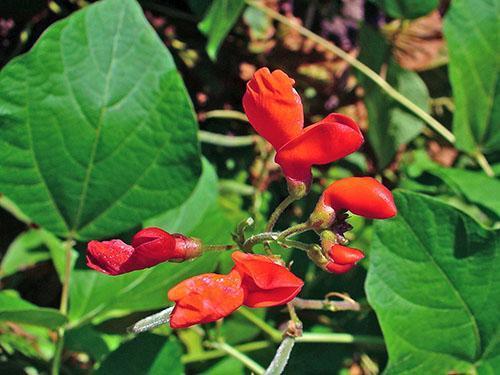 If the flowers of common beans, depending on the variety, can be white, lilac, pinkish or cream, then Turkish beans or, as this catchy plant is also called, fiery red beans strike with scarlet inflorescences. It is interesting that this species, which entered the territory of Russia two centuries before the usual vegetable beans, did not find wide distribution as a garden plant, but firmly settled in greenhouses and gardens.
If the flowers of common beans, depending on the variety, can be white, lilac, pinkish or cream, then Turkish beans or, as this catchy plant is also called, fiery red beans strike with scarlet inflorescences. It is interesting that this species, which entered the territory of Russia two centuries before the usual vegetable beans, did not find wide distribution as a garden plant, but firmly settled in greenhouses and gardens.
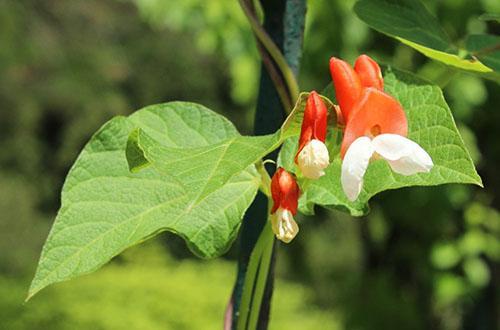 Turkish beans are very unpretentious and grow up to 3-4.5 meters with minimal care. When planted early, the plants bloom from mid-June to late September. If not long ago, summer cottages were decorated with vines blooming only with bright red racemose inflorescences, today varieties of curly beans have appeared, giving two-colored, salmon, burgundy and completely white flowers.
Turkish beans are very unpretentious and grow up to 3-4.5 meters with minimal care. When planted early, the plants bloom from mid-June to late September. If not long ago, summer cottages were decorated with vines blooming only with bright red racemose inflorescences, today varieties of curly beans have appeared, giving two-colored, salmon, burgundy and completely white flowers.
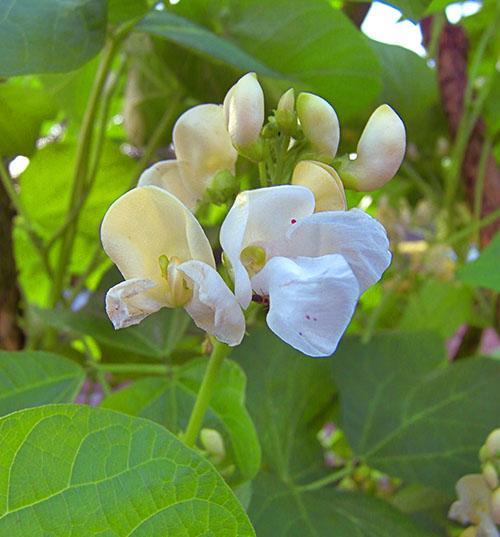 The plants are distinguished by numerous large foliage, which, like most legumes, has three separated lobes.In the presence of a solid support, the lashes willingly climb to great heights, easily braiding trellises, hedges and even tree crowns.
The plants are distinguished by numerous large foliage, which, like most legumes, has three separated lobes.In the presence of a solid support, the lashes willingly climb to great heights, easily braiding trellises, hedges and even tree crowns.
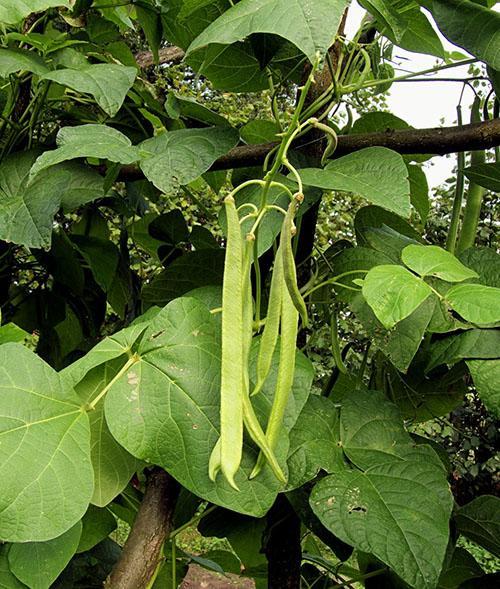 Young pods of this type of curly ornamental bean are inedible due to tough fibers and substances harmful to human digestion. The leaves of such beans are densely pubescent. Inside the pod, there can be from three to six seeds of a purple-pink color, a characteristic feature of which is contrasting dark streaks over the entire surface.
Young pods of this type of curly ornamental bean are inedible due to tough fibers and substances harmful to human digestion. The leaves of such beans are densely pubescent. Inside the pod, there can be from three to six seeds of a purple-pink color, a characteristic feature of which is contrasting dark streaks over the entire surface.
Ripe seeds, after soaking, are not inferior in taste and nutritional value to cultivated beans.
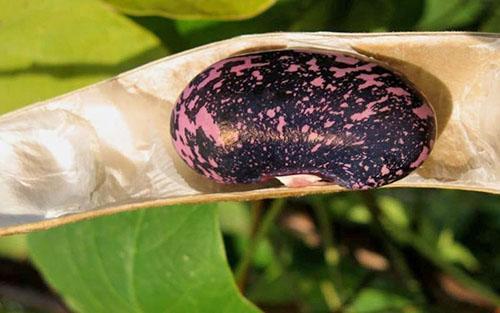 At the summer cottage, Turkish beans can be used to create vertical landscaping, and to create green shelters from the wind for heat-loving crops, for example, eggplant, melons or grapes.
At the summer cottage, Turkish beans can be used to create vertical landscaping, and to create green shelters from the wind for heat-loving crops, for example, eggplant, melons or grapes.
Dolichos purple (Lablab purpureus)
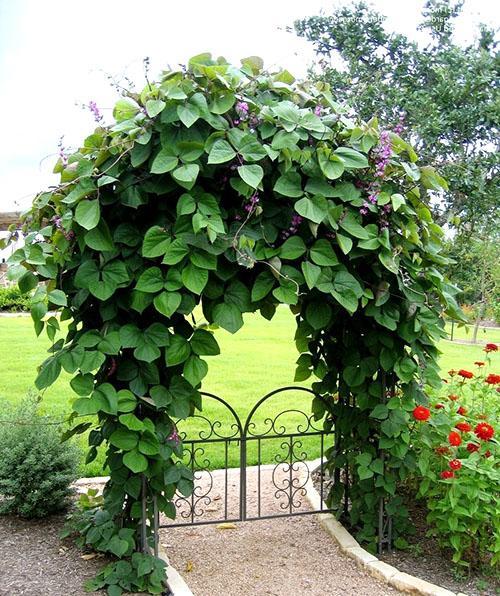 Another spectacular annual plant from the legume family is rightfully called the climbing lilac. With these ornamental shrubs, dolichos, lablab or hyacinth beans are related by the shade of flowers and the appearance of large, uniting up to four dozen buds, inflorescences.
Another spectacular annual plant from the legume family is rightfully called the climbing lilac. With these ornamental shrubs, dolichos, lablab or hyacinth beans are related by the shade of flowers and the appearance of large, uniting up to four dozen buds, inflorescences.
In Russia and other regions with a temperate climate, this water of decorative climbing beans is sown in spring, and by autumn the plants finish their vegetation. But in Africa and Asia, where the climate is warmer, and the duration of daylight hours is longer, dolichos is a large constantly blooming perennial.
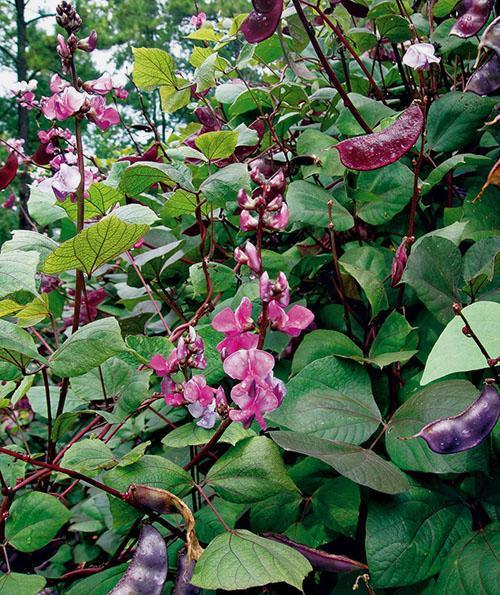 Under favorable weather conditions, the varieties of climbing beans of this species grow up to 1.5–3 meters and very quickly master the supports of various shapes and designs prepared for them. Thanks to abundant flowering and large, three-lobed leaves, hyacinth beans create a dense decorative coating. Moreover, depending on the variety, the purple color can spread not only to the inflorescences and valves of the beans, but also to the stems and even leaf blades.
Under favorable weather conditions, the varieties of climbing beans of this species grow up to 1.5–3 meters and very quickly master the supports of various shapes and designs prepared for them. Thanks to abundant flowering and large, three-lobed leaves, hyacinth beans create a dense decorative coating. Moreover, depending on the variety, the purple color can spread not only to the inflorescences and valves of the beans, but also to the stems and even leaf blades.
Today, gardeners have varieties at their disposal that delight both traditionally with lilac and purple flowers, and revealing white, pink, purple and even bicolor buds. Inflorescences appear from the sinuses, flowers, which retain their attractiveness for up to three days, open alternately, and the entire brush lives from 20 to 30 days.
Interestingly, dolichos is a rare decorative curly beans with a pleasant smell, so large inflorescences are sometimes included in bouquets. Flowers tolerate cutting easily and stay in water for up to 10-14 days. With the completion of flowering, the plants do not lose their decorative effect. Purple, violet or dark green curved beans are grouped in bunches of 5-15 and turn out to be no less spectacular than flowering beans in late summer. The pod length on average ranges from 8 to 12 cm.
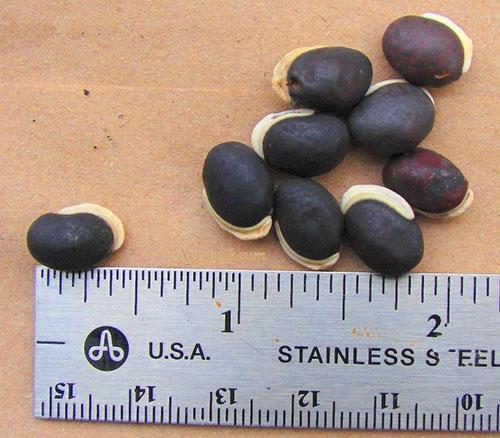 Elliptical, laterally compressed seeds of black or brown color ripen in the pods. On seeds not exceeding 1–1.5 cm in length, a white scar is clearly visible. The seeds have been edible and eaten by the peoples of northern Africa for thousands of years, and today they are a type of curly ornamental bean suitable for both garden planting and balcony boxes.
Elliptical, laterally compressed seeds of black or brown color ripen in the pods. On seeds not exceeding 1–1.5 cm in length, a white scar is clearly visible. The seeds have been edible and eaten by the peoples of northern Africa for thousands of years, and today they are a type of curly ornamental bean suitable for both garden planting and balcony boxes.
Vigna caracalla
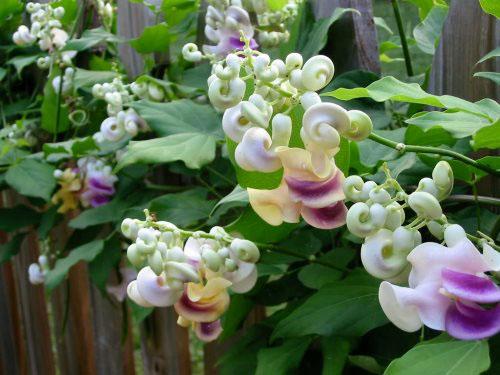 The name of the amazing climbing plant was given by the snail, which is so similar to the flowers of this variety of climbing beans. Vigna Caracalla, or according to an alternative classification, Cochliasanthus caracalla, is a perennial plant native to the tropics of South America. Vigna is one of the largest cultivated varieties of climbing beans. The shoots of the cowpea Caracalla can climb to a height of 7 meters.
The name of the amazing climbing plant was given by the snail, which is so similar to the flowers of this variety of climbing beans. Vigna Caracalla, or according to an alternative classification, Cochliasanthus caracalla, is a perennial plant native to the tropics of South America. Vigna is one of the largest cultivated varieties of climbing beans. The shoots of the cowpea Caracalla can climb to a height of 7 meters.
In the homeland of the culture, it is a perennial, but in temperate climates it is cultivated as an annual crop, and the species is quite thermophilic, therefore, wishing to save the plant for the winter, it is transferred to a room or to a heated greenhouse. Vignu, like other varieties of beans, is distinguished by a high rate of development and growth. Therefore, even with a short summer in the middle lane, curly ornamental beans successfully braid hedges, terraces and arches. The cowl is attached to the vertical surfaces with a strong mustache.The shape and appearance of the leaves of this culture is not much different from other types of beans, but the flowers are truly unique.
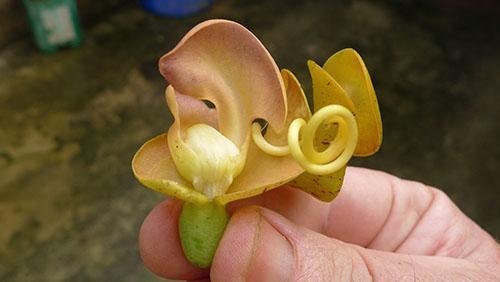 The petals that make up the corolla are twisted like a tight spiral. The diameter of the flower can reach 3-5 cm. Color, depending on the variety and age of the flower, can vary from white, yellowish or cream to purple and violet. The inflorescence of the cowpea is a brush, which may contain 5–12 gradually opening buds.
The petals that make up the corolla are twisted like a tight spiral. The diameter of the flower can reach 3-5 cm. Color, depending on the variety and age of the flower, can vary from white, yellowish or cream to purple and violet. The inflorescence of the cowpea is a brush, which may contain 5–12 gradually opening buds.
The flowers of this variety of curly beans are fragrant and quite durable. If the plant planted in the garden is not exposed to frost and cold wind, then its flowering lasts from July to the end of September.
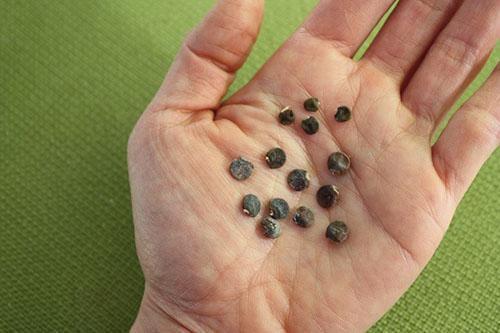 As a balcony culture, it is better to pinch a large plant in order to control the length of the shoots and periodically provoke flowering. For cowpea, they arrange supports from a rope mesh, onto which the growing stems are immediately directed. If you move an adult plant, you can easily break off rather fragile shoots.
As a balcony culture, it is better to pinch a large plant in order to control the length of the shoots and periodically provoke flowering. For cowpea, they arrange supports from a rope mesh, onto which the growing stems are immediately directed. If you move an adult plant, you can easily break off rather fragile shoots.
Winged beans (Psophocarpus tetragonolobus)
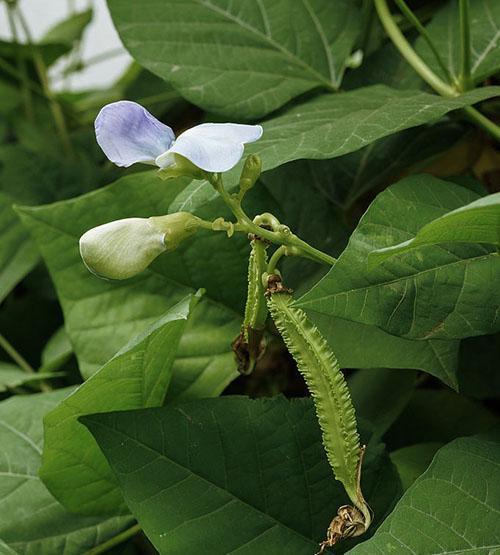 The most unusual type of curly ornamental beans first came to the territory of Russia quite recently, just a few years ago. But winged beans are well known in Goa, Thailand and New Guinea and other countries in the region.
The most unusual type of curly ornamental beans first came to the territory of Russia quite recently, just a few years ago. But winged beans are well known in Goa, Thailand and New Guinea and other countries in the region.
Here, beans with pods of an unusual shape for Russians have long been used for food. Moreover, for the preparation of culinary dishes, not only green juicy blades with four fancy blades and mature seeds are used, but also inflorescences and powerful three-lobed foliage. In local folk medicine, the plant is recognized as curative, which is now confirmed by European experts.
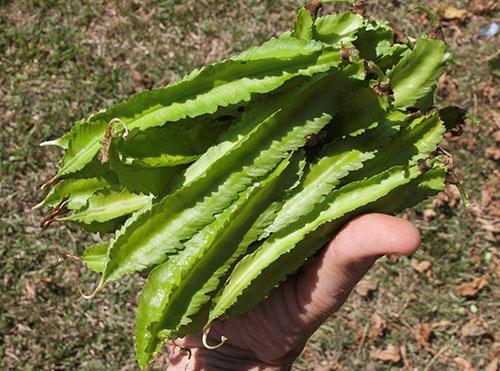 As decorative curly beans, winged beans are grown, like cowpea, trying to protect from the wind and cold. In Russian conditions, it is an annual plant that reaches 5 meters in height during the spring-summer season.
As decorative curly beans, winged beans are grown, like cowpea, trying to protect from the wind and cold. In Russian conditions, it is an annual plant that reaches 5 meters in height during the spring-summer season.
Inflorescences of winged beans are racemose, large, up to 15 cm in length. In each such brush, you can count from 5 to 15 blue, cream or two-colored corollas up to 3 cm in diameter.After flowering, this variety of curly beans forms amazing tetrahedral shoulder blades, which, depending on growing conditions and varieties, grow up to 10-25 cm in length. On some plants, there are truly giant beans up to 40 cm in length.
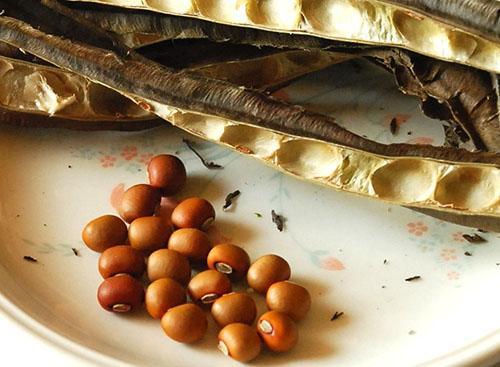 Inside the pod, from 5 to 20 almost round smooth seeds with a diameter of up to 10 mm ripen. The colors of the edible beans can be varied. The different varieties of this type of curly bean have brown, brown, yellow and black seeds.
Inside the pod, from 5 to 20 almost round smooth seeds with a diameter of up to 10 mm ripen. The colors of the edible beans can be varied. The different varieties of this type of curly bean have brown, brown, yellow and black seeds.
How to plant beans near a support - video